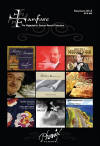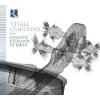Texte paru dans: / Appeared in:

Fanfare Magazine: 36:5 (05-06/2013)
Pour
s'abonner / Subscription information
Les abonnés à Fanfare Magazine ont accès aux archives du
magazine sur internet.
Subscribers to Fanfare Magazine have access to the archives of the magazine
on the net.
Ricercar
RIC326

Code-barres / Barcode : 5400439003262 (ID312)
Consultez toutes les évaluations recensées pour ce cd
~~~~ Reach all the evaluations located for this CD
The two Vitalis, both composers, are sometimes confused on radio broadcasts and in concert hall notes, so let’s begin by noting the differences. Giovanni Battista Vitali (1632-1692) was a Bolognese violinist and cellist of high regional esteem, singing and performing with other musicians in the Basilica San Petronio, and a member of the prestigious Accademia Filarmonica. He eventually became maestro di cappella at San Petronio, and then left for employment with the music-loving d’Estes. Bologna was part of the Papal States by conquest during this period, but it also flourished as a center of commerce, the sciences, and the arts—which may account for Vitali’s awareness of, and ability to write within, a variety of Italian and French musical styles. The group of 10 short works on this album lies firmly in the Italian folk-popular monophonic tradition. They include dance movements (a forlane, two bergamascas, a passamezzo), and more serious, virtuosic fare (a toccata for solo violin, a sonata da chiesa in five movements) whose manner recalls Corelli.
Tomaso Antonio Vitali (1663-1745) traveled with his father to serve the d’Este dukes in Modena in 1674. He became leader of the orchestra there, and in fact remained on the pay register until three years before his death. Unlike his father, who issued numerous collections of balletti and balli as well as early sonatas, Tomaso’s published works are almost entirely trio sonatas, though sometimes these incorporate titles and distinctive rhythms and harmonies of French contemporary music. The famous Ciaconna so long considered by Vitali thanks to a single Dresden manuscript attribution (Parte dal Tomaso Vitalino) is now regarded as doubtful. The selection of his music on this recording includes that work, as well as another ciaconna (more Italianate in nature, but with some similarly jarring harmonic changes), two trio sonatas, and a passamezzo.
I’ve reviewed Clematis twice before. The first was an album of music by Carlo Farina (Ricercar 285) that was stiffly phrased and inexpressive. The latter, devoted to works by Matheo Romero (Ricercar 308), was by contrast full of high spirits and crisply accented rhythms. This album fortunately follows along the lines of the latter. Accompaniment textures are varied, alternating among theorbo, guitar, harp, bass viol, and organ. Percussion is added on occasion, sometimes to excellent effect, as in the break in the middle of G. B. Vitali’s Furlana, where it fits the accelerating tempo and excitement of the music; sometimes less so, as in T. A. Vitali’s Passo e mezzo where it seems out of place given the more abstract, less folk-like music, and obscures the lower of the two lines. All performances are vital and technically fluent, with especial praise due to violinist Stéphanie de Failly. She easily moves between a lean, rhythmically punchy style appropriate to the folk-like material, and a more classically appropriate one with a disciplined, patrician tone for the sonatas and chaconnes. The sound is excellent, as is true in general of Ricercar’s releases. Strongly recommended.
Cliquez l'un ou l'autre
bouton pour découvrir bien d'autres critiques de CD
Click either button for many other reviews


